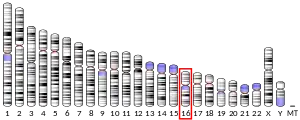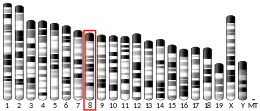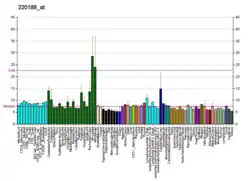JPH3
Junctophilin-3 is a protein in humans that is encoded by the JPH3 gene. The gene is approximately 97 kilobases long and is located at position 16q24.2. Junctophilin proteins are associated with the formation of Junctional Membrane Complexes, linking the plasma membrane with the Endoplasmic reticulum in excitable cells.[5] Junctophilin-3 is specific to the brain and has an active role in neurons involved in motor coordination and memory.[6]
| JPH3 | |||||||||||||||||||||||||||||||||||||||||||||||||||
|---|---|---|---|---|---|---|---|---|---|---|---|---|---|---|---|---|---|---|---|---|---|---|---|---|---|---|---|---|---|---|---|---|---|---|---|---|---|---|---|---|---|---|---|---|---|---|---|---|---|---|---|
| Identifiers | |||||||||||||||||||||||||||||||||||||||||||||||||||
| Aliases | JPH3, CAGL237, HDL2, JP-3, JP3, TNRC22, junctophilin 3 | ||||||||||||||||||||||||||||||||||||||||||||||||||
| External IDs | OMIM: 605268 MGI: 1891497 HomoloGene: 10762 GeneCards: JPH3 | ||||||||||||||||||||||||||||||||||||||||||||||||||
| |||||||||||||||||||||||||||||||||||||||||||||||||||
| |||||||||||||||||||||||||||||||||||||||||||||||||||
| |||||||||||||||||||||||||||||||||||||||||||||||||||
| |||||||||||||||||||||||||||||||||||||||||||||||||||
| Wikidata | |||||||||||||||||||||||||||||||||||||||||||||||||||
| |||||||||||||||||||||||||||||||||||||||||||||||||||
The protein sequence comprises 748 amino acid residues and consists of a C-terminal hydrophobic segment that spans the Endoplasmic/Sarcoplasmic reticulum membrane, and a remaining cytoplasmic domain that shows specific affinity for the plasma membrane. The protein contains several MORN (membrane occupation and recognition nexus) repeats that contribute to plasma membrane binding through interactions with phospholipids.
Junctophilin-3 exhibits predominant expression in the brain, specifically within the dorsolateral prefrontal cortex. Although the precise function of the protein has not been determined, it has been demonstrated to play a role in motor coordination and memory through efficient calcium ion signaling[7] and the stabilization of neuronal cellular architecture.[8]
The JPH3 gene contains a CAG/CTG trinucleotide repeat segment. This segment's expansion is associated with several Polyglutamine diseases (polyQ), which include Spinocerebellar ataxia, Huntington's disease, and Huntington's disease-like 2 (HDL2). The pathological expansion of the CAG repeat coding region leads to an expanded polyQ tract,[9] which aggregate in degenerated neurons leading to the degeneration of specific neuronal subpopulations.[10]
References
- GRCh38: Ensembl release 89: ENSG00000154118 - Ensembl, May 2017
- GRCm38: Ensembl release 89: ENSMUSG00000025318 - Ensembl, May 2017
- "Human PubMed Reference:". National Center for Biotechnology Information, U.S. National Library of Medicine.
- "Mouse PubMed Reference:". National Center for Biotechnology Information, U.S. National Library of Medicine.
- Takeshima H, Komazaki S, Nishi M, Iino M, Kangawa K (July 2000). "Junctophilins: a novel family of junctional membrane complex proteins". Molecular Cell. 6 (1): 11–22. doi:10.1016/S1097-2765(05)00005-5. PMID 10949023.
- Nishi M, Mizushima A, Nakagawara K, Takeshima H (July 2000). "Characterization of human junctophilin subtype genes". Biochemical and Biophysical Research Communications. 273 (3): 920–927. doi:10.1006/bbrc.2000.3011. PMID 10891348.
- Nishi M, Hashimoto K, Kuriyama K, Komazaki S, Kano M, Shibata S, Takeshima H (March 2002). "Motor discoordination in mutant mice lacking junctophilin type 3". Biochemical and Biophysical Research Communications. 292 (2): 318–324. doi:10.1006/bbrc.2002.6649. PMID 11906164.
- Seixas AI, Holmes SE, Takeshima H, Pavlovich A, Sachs N, Pruitt JL, et al. (February 2012). "Loss of junctophilin-3 contributes to Huntington disease-like 2 pathogenesis". Annals of Neurology. 71 (2): 245–257. doi:10.1002/ana.22598. PMID 22367996. S2CID 6432652.
- Chen Z, Sequeiros J, Tang B, Jiang H (December 2018). "Genetic modifiers of age-at-onset in polyglutamine diseases". Ageing Research Reviews. 48: 99–108. doi:10.1016/j.arr.2018.10.004. PMID 30355507. S2CID 53027229.
- Fan HC, Ho LI, Chi CS, Chen SJ, Peng GS, Chan TM, et al. (May 2014). "Polyglutamine (PolyQ) diseases: genetics to treatments". Cell Transplantation. 23 (4–5): 441–458. doi:10.3727/096368914X678454. PMID 24816443. S2CID 27522175.
External links
Further reading
- Margolis RL, Abraham MR, Gatchell SB, Li SH, Kidwai AS, Breschel TS, et al. (July 1997). "cDNAs with long CAG trinucleotide repeats from human brain". Human Genetics. 100 (1): 114–122. doi:10.1007/s004390050476. PMID 9225980. S2CID 25999127.
- Olin KL, Potter-Perigo S, Barrett PH, Wight TN, Chait A (January 2001). "Biglycan, a vascular proteoglycan, binds differently to HDL2 and HDL3: role of apoE". Arteriosclerosis, Thrombosis, and Vascular Biology. 21 (1): 129–135. doi:10.1161/01.ATV.21.1.129. PMID 11145944.
- Holmes SE, O'Hearn E, Rosenblatt A, Callahan C, Hwang HS, Ingersoll-Ashworth RG, et al. (December 2001). "A repeat expansion in the gene encoding junctophilin-3 is associated with Huntington disease-like 2". Nature Genetics. 29 (4): 377–378. doi:10.1038/ng760. PMID 11694876. S2CID 23976552.
- Stevanin G, Camuzat A, Holmes SE, Julien C, Sahloul R, Dodé C, et al. (March 2002). "CAG/CTG repeat expansions at the Huntington's disease-like 2 locus are rare in Huntington's disease patients". Neurology. 58 (6): 965–967. doi:10.1212/wnl.58.6.965. PMID 11914418. S2CID 34200149.
- Grimsby S, Jaensson H, Dubrovska A, Lomnytska M, Hellman U, Souchelnytskyi S (November 2004). "Proteomics-based identification of proteins interacting with Smad3: SREBP-2 forms a complex with Smad3 and inhibits its transcriptional activity". FEBS Letters. 577 (1–2): 93–100. doi:10.1016/j.febslet.2004.09.069. PMID 15527767. S2CID 82568.
- Ewing RM, Chu P, Elisma F, Li H, Taylor P, Climie S, et al. (2007). "Large-scale mapping of human protein-protein interactions by mass spectrometry". Molecular Systems Biology. 3 (1): 89. doi:10.1038/msb4100134. PMC 1847948. PMID 17353931.




